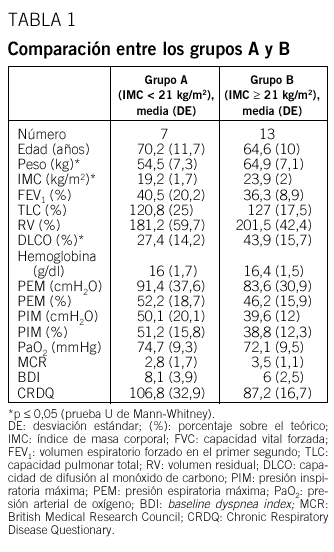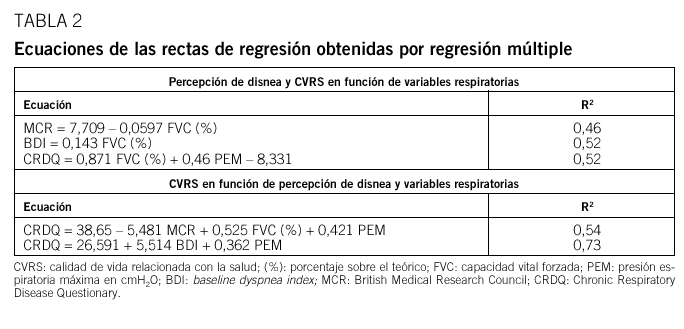Fundamento: Valorar las diferencias en función respiratoria, calidad de vida (CVRS) y disnea en pacientes con enfermedad pulmonar obstructiva crónica (EPOC) tipo enfisema según el índice de masa corporal (IMC). Estudiamos también la relación entre el IMC, la función respiratoria, la CVRS y la disnea.
Pacientes y método: Durante 12 meses incluimos prospectivamente a 20 pacientes con EPOC tipo enfisema clasificados en grupo A (IMC < 21 kg/m2) y grupo B (IMC >= 21 kg/m2). Determinamos los parámetros de función respiratoria, la escala de disnea y el cuestionario de CVRS.
Resultados: Siete pacientes tenían un IMC inferior a 21 kg/m2 y 13 un IMC de 21 kg/m2 o superior. Los pacientes del grupo A tuvieron menor capacidad de difusión al monóxido de carbono (DLCO). Al realizar un análisis multivariante la FVC explicaba un 52% de la variabilidad de la percepción de disnea. Los parámetros que mejor predecían la CVRS fueron la presión espiratoria máxima (PEM) y la disnea.
Conclusiones: Los pacientes con enfisema e IMC menor de 21 kg/m2 tienen una disminución de la DLCO respecto al grupo con IMC de 21 kg/m2 o superior. La percepción de disnea en estos pacientes depende de la FVC. La CVRS se explica fundamentalmente por la percepción de disnea y la PEM.
Background: We aimed to evaluate the differences in pulmonary function, quality of life (CVRS) and dyspnea in patients with chronic obstructive pulmonary disese (COPD) and emphysema according to the body mass index (BMI). Moreover, we analyzed the relation between BMI, pulmonary function, CVRS and dyspnea.
Patients and method: This was a prospective, 12-months study including 20 patients with COPD and emphysema. They were classified in group A (BMI < 21 kg/m2 group B (BMI >= 21 kg/m2). We performed pulmonary function tests and determined the levels of dyspnea and CVRS according to a scale of dyspnea and a CVRS questionnaire.
Results: Seven patients had a BMI < 21 kg/m2 and it was >= 21 kg/m2 in 13 patients. DLCO in group A patients was lower than in group B. After a multiple regression analysis, the FVC accounted for 52% of dyspnea variability. Both PEM and dyspnea were the parameters that better predicted the CVRS.
Conclusions: Patients with COPD and emphysema with a VMI < 21 kg/m2 have a lower DLCO than patients with a BMI >= 21 kg/m2. In our patients, dyspnea sensation depended on the FVC. In addition, the CVRS depended on dyspnea sensation and PEM.
Artículo
Comprando el artículo el PDF del mismo podrá ser descargado
Precio 19,34 €
Comprar ahora








